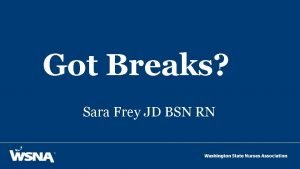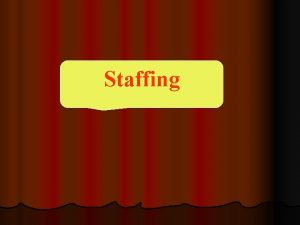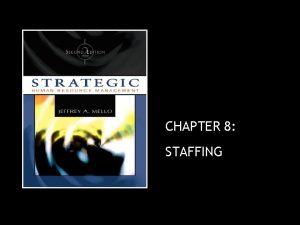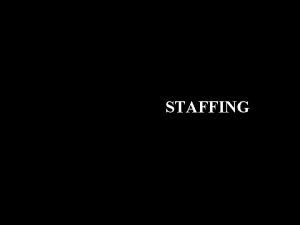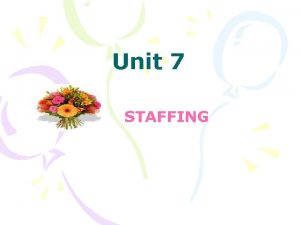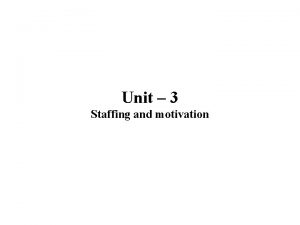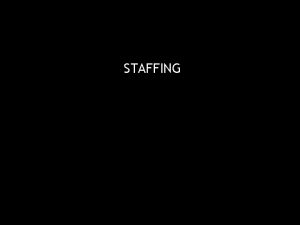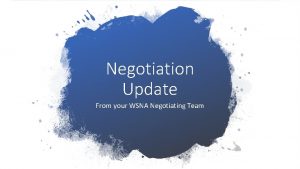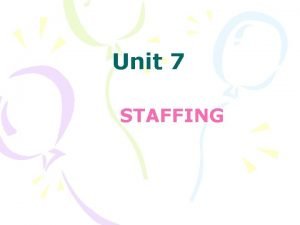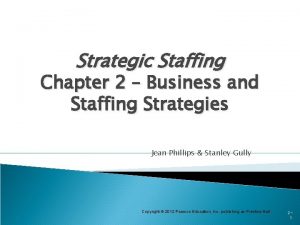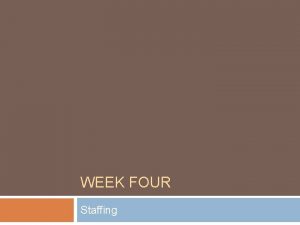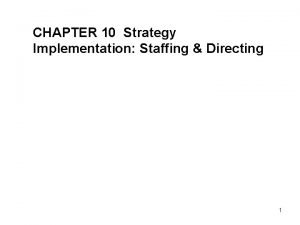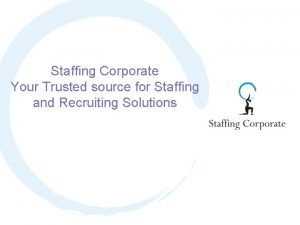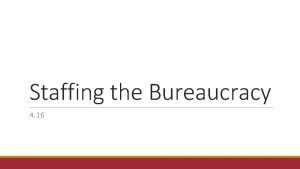Making the staffing law work for us WSNA

























































- Slides: 57

Making the staffing law work for us WSNA Executive Director Sally Watkins, Ph. D, RN

Objectives We will: 2 • Review the Washington state staffing law • Present recommendations and tools from collaborative effort between hospital association and union leaders • Discuss practical strategies for making Staffing Committees more engaging and useful • Provide overview of next steps in effort to make staffing law work • Explore next steps as the current Washington state staffing law sunsets in 2023

2017 Patient Safety Act 3 • Greater transparency of staffing plans • Increase accountability in adoption of staffing plan • Strengthen staffing committees • Provides pathway for accountability if staffing plan is not followed

Nurse Staffing Committee Checklist NSC composition and participation 4 q At least 50% are staff nurses (RNs providing direct patient care). q Staff nurses on the NSC are selected by the union if RNs represented by union. q Participation on NSC shall be scheduled work time, relieved of all other work duties, and paid. q No retaliation or intimidation of employees serving on NSC or reporting concerns to NSC.

Nurse Staffing Committee Checklist NSC primary responsibilities 5 q Development & oversight of annual patient care unit & shift staffing plan based on patient care needs. q Semiannual review of staffing plan against patient need & evidencedbased info (nursing sensitive indicators). q Review, assess, and respond to staffing variations/concerns/complaints reported to the NSC. q q Track complaints reported to the NSC. Track resolution of each complaint by NSC (resolved, dismissed, unresolved).

Nurse Staffing Committee Checklist Key elements in development of staffing plan q q q q q 6 Census, including total number of patients on unit/shift including discharges, admissions, and transfers. Level of intensity of all patients and nature of care delivered on each shift. Skill mix. Level of experience and specialty certification or training. Need for specialized or intensive equipment. Layout of patient care unit including placement of patient rooms, treatment areas, nursing stations, medication prep areas, and equipment. Staffing guidelines adopted by national nursing profession and specialty nursing organizations. Availability of other personal supporting nursing services. Strategies to enable nurses to take meal and rest breaks.

Nurse Staffing Committee Checklist Staffing plan posting, disclosure, implementation and complaint Posting q Posting of nurse staffing plan and actual staffing levels (nurses and relevant clinical staff) for that shift in public area on each patient care unit. Plan approval and implementation q CEO provide written explanation if staffing plan from NSC is not adopted, and prepare alternate staffing plan. q Hospital must implement staffing plan (either original NSC plan or alternative by CEO) and assign nursing personnel to each unit according to plan beginning January 1, 2019. Reporting disclosure q Hospital must submit staffing plan (either original NSC plan or alternative by CEO) to Department of Health beginning January 1, 2019. q Hospital must submit staffing plan annually and at any time in between when plan is updated. Report to NSC for violations 7 q Variations where the staffing level is not in accordance with the adopted staffing plan q Disagreement with shift-to-shift staffing adjustments made by management

DOH investigation triggers o A pattern of unresolved complaints o No staffing committee o No semi-annual review of a staffing plan o No staffing plan on file with DOH 8

DOH investigation triggers o Failure to follow staffing plan or shift-to-shift adjustments Ø Ø 9 evidence indicating a continuing pattern of unresolved violations for a minimum of 60 day continuous period Excludes unforeseeable emergency circumstances or documented reasonable efforts to obtain staffing

2017 Patient Safety Act 10 • Requires the Washington State Department of Health to submit a report to the legislature by December 31, 2020. • Include the number of complaints submitted, investigated, associated costs to DOH and any recommended changes to statute. • Requires a stakeholder group including WSNA to review the report before it is submitted to the legislature. • This act expires on June 1, 2023.

Coalition– WSNA, WSHA, SEIU 1199 NW, UFCW 21 Development and dissemination of guidelines/materials ü Updated charter template ü NSC checklist ü Standardize tracking of staffing committee resolution of staffing complaints ü Draft complaint form for submission to staffing committee ü Decision tree for staffing committee evaluation of staffing complaints ü Checklist & attestation for staffing plan submission to DOH 11

NSC Checklist 12

NSC charter template Committee membership & leadership • Co-chairs: staff nurse rep & management rep • List of members including clinical area/unit • Staff nurse participants selected by the union 13

NSC charter template Overall purpose/strategic objective • Access to data including: Ø Ø Ø Ø 14 Patient census & variances Quality metrics such as Nursing Sensitive Indicators (falls, HAPU, etc. ) staff engagement/experience Utilization of overtime, on-call, travelers Missed breaks Staffing concerns (e. g. ADOs) Recruitment, retention, turnover Education, vacation, sick time, leave of absences

NSC charter template Tasks/functions • Develop/produce and oversee establishment of annual patient care unit and shift-based staffing plan and staffing plan modifications. • Consider factors in the development of staffing plans: Ø Availability of other personnel supporting nursing services Ø Strategies to enable RNs to take meal and rest breaks • Tracking, responding, resolving complaints • Orientation of staffing law 15

Complaint form A nurse questioning an assignment is encouraged to communicate this concern in the following manner: 16 • Discuss the concern with the person responsible for the assignment on that shift. • The supervisor should attempt to resolve the situation using available resources as he/she determines appropriate. • If the nurse is dissatisfied with the decision of the supervisor, the nurse should fill out a complaint form as soon as possible. • If there is no mutually satisfactory resolution to the problem, and the problem appears to be one which will be recurring, the nurse may submit their documentation to the unit or hospital staffing committee (and/or to the nurse’s local bargaining unit, as appropriate). • Nurses who raise assignment concerns should be free from restraint, interference, discrimination, or reprisal.

Accepted v. dismissed complaints Dismissed complaints • The hospital follows the nursing personnel assignments in a patient care unit as called for in the nurse staffing plan • Evidence does not support the staffing complaint • Hospital documents it has made reasonable efforts to obtain staffing but has been unable to • Incident causing the complaint occurred during an unforeseeable emergency > any unforeseen national, state, or municipal emergency; > when a hospital disaster plan is activated; > any unforeseen natural disaster or catastrophic event that substantially affects or increases the need for health care services; or > when a hospital is diverting patients to another hospital or hospitals for treatment or the hospital is receiving patients from another hospital or hospitals. Accepted complaints 17 • The hospital does NOT follow the nursing personnel assignments in a patient care unit or shift-to-shift adjustments in staffing levels as called for in the nurse staffing plan • Nurse disagrees with shift-to-shift adjustments made by management

Resolved vs. unresolved complaints Resolved complaints • Nurse staffing committee agrees that the complaint has been resolved Unresolved complaints • Nurse staffing committee agrees that the complaint was not resolved • Nurse staffing committee is unable to agree that the complaint has been resolved 18

Complaint made to NSC Complaint Process Decision Tree Pattern of unresolved complaints over 60 day continuous period = complaint to DOH NSC determines if complaint is accepted/valid No further action required Dismissed Accepted No further action required Resolved NSC attempts to resolve Unresolved *NSC agrees there is no resolution *NSC is unable to agree if the complaint was resolved

Complaint tracking form > Name of person making complaint > Role (staff, charge, etc. ) > Date & time of incident, unit, shift > Type of complaint (staffing plan deviation, patient safety, etc. ) > Date NSC received complaint > Date when complaint was considered by NSC > Date determination was made by NSC > What was the determination > Did everyone agree with determination? If no, why not? 20

DOH staffing plan submission CHECKLIST Matrix by unit and shift - Each plan should include a matrix of core required staff by unit and shift dependent on the number of patients for which care is being provided. Matrices may vary by type of unit or type of shift Any matrix should include the following information: q Designated shift or start times; and q Number of RNs per shift/start time by census or cases. If applicable, matrices may include the following additional information: q Number of charge nurses; q Number and type of support staff; q Adjustments to staffing numbers based on patient needs (e. g. , certain stages of labor require multiple nurses, complex surgeries may require additional nurses and staff, etc. ); and/or q Available staff on-call. Additional materials or language that describe plans to provide the staffing necessary for: q Breaks; q Planned leave; and q Unplanned leave. 21

DOH staffing plan submission HOSPITAL ATTESTATION I, the undersigned with responsibility for _________ (hospital/health system name), attest that the attached staffing plan and matrix was developed in accordance with RCW 70. 41. 420 for the ________ (year) and includes all units covered under our hospital license under RCW 70. 41. This plan was developed with consideration given to the following elements (please check): q Census, including total numbers of patients on the unit on each shift and activity such as patient discharges, admissions, and transfers; q Level of intensity of all patients and nature of the care to be delivered on each shift; q Skill mix; q Level of experience and specialty certification or training of nursing personnel providing care; q The need for specialized or intensive equipment; q The architecture and geography of the patient care unit, including but not limited to placement of patient rooms, treatment areas, nursing stations, medication preparation areas, and equipment; q Staffing guidelines adopted or published by national nursing professional associations, specialty nursing organizations, and other health professional organizations; q Availability of other personnel supporting nursing services on the unit; and q Strategies to enable registered nurses to take meal and rest breaks as required by law or the terms of an applicable collective bargaining agreement, if any, between the hospital and a representative of the nursing staff. 22

Coalition– WSNA, WSHA, SEIU 1199 NW, UFCW 21 Development and dissemination of guidelines/materials ü Updated charter template ü NSC checklist ü Standardize tracking of staffing committee resolution of staffing complaints ü Draft complaint form for submission to staffing committee ü Decision tree for staffing committee evaluation of staffing complaints ü Checklist & attestation for staffing plan submission to DOH Training & education • Joint webinar • https: //www. wsna. org/nursing-practice/safe-nurse-staffing/resources 23

Previously identified gaps 24 • Missing CEO documentation if plan denied • Inconsistent quality in submitted staffing plans • Semiannual reviews inconsistent • Posting staffing plans not always compliant • Not all hospitals compliant with Staffing Committee implementation requirements

Challenges facing Staffing Committees The current health care environment: 25 • Corporatization of health care and the impact on structure and compliance • Turnover in nursing and system leadership • Mismatch of supply and demand of nursing and other skilled staff • Lengthy contract negotiations may impede regular Staffing Committee meetings • Uncertainly of hospital finances and more payments being tied to defined outcomes and performance

Strategies to Increase Effectiveness Understand how staffing plans become budgets: • Units of Service • Calculating FTEs • Additional worked time – orientation, education, meetings • Paid-not worked time – PTO, etc. Gain an understanding of finance 26

Units of Service Midnight Census (Average Daily Census)/historical data Hmmmm…… Observation Patients = “Equivalent Patient Day” Total observation hours divided by 24 Hrs + ADC 27


Mix Chg RN RN LPN CNA HUC Total Staff Total Shift 7 a. m. – 3 p. m. 1 9 3 1 14 1 8 2 36% 3 – 11 p. m. 36% 11 p. m. – 7 a. m. 28% 29 11 39 x 1. 4 = 54. 6

3 0 12 Hour Shifts 12 hr shift X 7 days/wk = 84 hrs/wk ÷ 40 hrs = 30 2. 1

3 1 The Non-Direct Care hours factor Unit history: Paid time – not worked: Paid time – not Direct Care Vacation = 4860 hours Sick = 4124 hours Holidays = 3240 hours Jury duty = 80 hours Bereavement = 216 hours Education/unit meetings = 3314 hours Residency hours = 4800 TOTAL Hours = 20, 634 Divide by 2080* = 9. 92 additional FTEs needed * 2080 = number of total paid hours per 1. 0 FTE

3 2 Where do I find my hospital’s staffing plan? > https: //www. doh. wa. gov/Dataand. Statistical. Reports/ Healthcarein. Washington/Hospitaland. Patient. Data/H ospital. Policies > Select hospital/facility name > Select Nurse Staffing link > Staffing plan should include all units/departements on the hospital’s license where nursing care is provided 32

Own your metrics Medical errors now the 3 rd leading cause of death! Nursing sensitive outcome measures: • CAUTI • CLABSI • Falls • Pressure Ulcers • HCAHPS and the Patient Experience 33

CMS Value-Based Payment 34

Medicaid Health care authority agreement: 35 • First Medicaid Quality Incentive in country passed by WA State Legislature 2010 • Tied to Hospital Safety Net Assessment • Measures selected: CAUTI, CLABSI, HAPU • Based on points earned, hospital can receive 1% payment increase (no partial % permitted) • Can earn two bonus points if answer all three questions related to Staffing Committee

Benchmarking processes and pressures Mapping to find “peer groups” Organization determination of what performance level to achieve i. e. “better than 75% of peers” = 25 th percentile goal National databases Limitations: • How know targets are “good”? • Who is included in the database? Large enough peer groups? • What characteristics are “mapped”? • Is quality outcome data included in the mapping? 36

Metrics in relationship to one another Financial metrics • Productivity • Overtime • Agency HR metrics • Turnover • Vacancy rate Quality • Patient Experience • CMS/NDNQI measures • Other (missed care) 37

Search for evidence on how to improve your practice Levels of evidence: • Level 1: Experimental studies, randomized clinical trials, meta analysis of randomized clinical trials • Level 2: Quasi-experimental studies • Level 3: Nonexperimental or qualitative studies • Level 4: Opinion of nationally recognized experts based on research evidence or expert consensus panel • Level 5: Opinions of individual experts based on non-research evidence; case studies, literature reviews, personal experience 38

Speed dating Questions for literature review What was the issue? • Do I see this in my practice? Who did they study? • Are the subjects similar to my patients? What did they do? • Is it realistic or feasible for my setting? What were the results? • Do the outcomes matter to my patients? Any concerns? - Elizabeth Bridges 39

Does your organization have a “Staffing Philosophy”? Written standard of practice • Guidelines to maximize safe staffing and promote nurse satisfaction • Role of Charge RN • How staffing will be “flexed” • Fatigue management • Support for critical incident debriefing and “recovery” time 40

Improve communication Sample staff survey (using 1 -5 scale) • • 41 The workload on my unit is manageable I am able to give my patients safe care I have time to meet the educational and emotional needs of my patients and their families I have time to thoroughly evaluate and assess my patients I am able to take my breaks and meals at a reasonable time Staffing assignments are able to accommodate “unit churn” (ADT) I have adequate time to orient new staff/precept students I am able to complete my work (including documentation) during my shift

…And more communication Avoid mandatory subjects of bargaining 42 • Hours, wages, working conditions • Length of shifts • Rest between shifts • Call back and standby provisions • On call shifts • Vacation time-how granted, when taken etc • Premium pay • Low census • Bonus pay

St. Elsewhere Medical Center Nurse Staffing Committee: Annual Calendar February 15 December 14 January 15 Budget education Annual assessment planning Meals and breaks review Staffing alerts/CSIs Dept. staffing reports Staffing alerts/CSIs November 15 Dept. staffing reports Finalize committee recommendations Submit recommendations to President (Budget development begins) Staffing alerts/CSIs Department surveys and assessments in process Staffing alerts/CSIs March 15 Nurse quality indicators Education and review Final approval of recommendations Staffing alerts/CSIs October 15 April 15 2016 assessment planning Meals and breaks Staffing alerts/CSIs Meals and breaks review Staffing alerts/CSIs September 15 May 15 Semi annual review Nurse quality indicators Staffing alerts/CSIs June 15 August 15 Semi annual review Staffing alerts/CSIs July 15 Meals and breaks Staffing alerts/CSIs (New budget year begins) Nurse quality indicators Staffing alerts/CSIs

Hospital quality data CMS & WSHA • Centers for Medicare and Medicaid Services (CMS) Hospital Compare - www. medicare. gov/hospitalcompare is part of the Centers for Medicare & Medicaid Services (CMS) Hospital Quality Initiative. • Washington Hospital Quality data from the Washington State Hospital Association - http: //www. wahospitalquality. org/ 44

45

Hospital quality data Washington State Adverse Events Reporting 46 • Adverse events are medical errors that healthcare facilities could and should have avoided. The National Quality Forum (NQF) defines these errors, which are also called serious reportable events. Washington State law (chapter 70. 56 RCW) requires healthcare facilities to report to the Department of Health whenever they confirm an adverse event. • Link to full list of NQF adverse events: https: //www. doh. wa. gov/Portals/1/Documents/Pubs/689003. pdf • Link to reports from individual hospitals: https: //www. doh. wa. gov/For. Public. Healthand. Healthcare. Providers/ Healthcare. Professionsand. Facilities/Patient. Care. Resources/Adverse. E vents/Quarterly. Reports

47

Hospital quality data Leap Frog 48 • Leapfrog Group is a private organization dedicated to educating consumers about quality health care) http: //www. leapfroggroup. org/ • Leapfrog Hospital Safety Grade http: //www. hospitalsafetygrade. org/ • The Leapfrog Hospital Safety Grade uses national performance measures from the Centers for Medicare & Medicaid Services (CMS), the Leapfrog Hospital Survey, the Agency for Healthcare Research and Quality (AHRQ), the Centers for Disease Control and Prevention (CDC), and the American Hospital Association’s Annual Survey and Health Information Technology Supplement. Taken together, those performance measures produce a single letter grade representing a hospital’s overall performance in keeping patients safe from preventable harm and medical errors.

49

50

What one thing will YOU do? How can you start making your staffing committee more effective? 51 • Develop/revisit Committee Charter. • Review your metrics and develop a staffing committee dashboard. • Standardize the tracking of key information and clarify ownership for tracking. • Invite your CFO to your Staffing Committee to provide a budget overview, i. e. “the state of the organization”, comparison to other “like” organizations. • Ensure nurses understand when, how and where to complete an ADO every time the hospital is not staffing to its plan including for missed breaks or use of break buddy system. • Review your Assignment Despite Objection forms during a Staffing Committee meeting. Are there trends? • Design a staff survey tool to evaluate perceived effectiveness of staffing.

REMEMBER WE HAVE PROOF! Appropriate nurse staffing levels are essential to optimizing quality of care and patient outcomes in this era of value-based healthcare. Avalere Health. September, 2015. Optimal Nurse Staffing to Improve Quality of Care and Patient Outcomes. Prepared for the American Nurses Association 52

53

REMEMBER WE HAVE PROOF! > Patterns of unresolved complaints lead to DOH complaints > Since fall of 2019, WSNA has filed at least 17 complaints where hospitals have failed to follow the staffing law or have patterns of unresolved complaints > These DOH complaints are forming a paper trail showing the deficits and loopholes in the current Patient Safety Act > We have an opportunity to fix those deficits during the 2023 session, during which the Patient Safety Act must be opened and extended before it sunsets on June 1, 2023 YOUR ADOs WILL MAKE OUR CASE! 54

Next steps 55 • Assess your staffing committee • Provide committee member training • Review ADOs and track review outcomes • Negotiate stronger contract language where needed • Evaluate ongoing effectiveness and employer compliance • Understand the metrics – what is being monitored and the trends • Track patterns of unresolved complaints and work with WSNA to file DOH complaints when warranted • 2017 Patient Safety Act sunsets on June 1, 2023, meaning the legislature must keep, change, or significantly revise this legislation during the 2023 session. • Federal legislation on staffing

It’s all about our patients! 56

THANK YOU! 57
 Wsna evergreen contract
Wsna evergreen contract Newton's first law and second law and third law
Newton's first law and second law and third law Si unit of newton's first law
Si unit of newton's first law V=k/p
V=k/p Charles law constant
Charles law constant Making inferences
Making inferences War making and state making as organized crime
War making and state making as organized crime Fspos vägledning för kontinuitetshantering
Fspos vägledning för kontinuitetshantering Typiska drag för en novell
Typiska drag för en novell Nationell inriktning för artificiell intelligens
Nationell inriktning för artificiell intelligens Returpilarna
Returpilarna Varför kallas perioden 1918-1939 för mellankrigstiden?
Varför kallas perioden 1918-1939 för mellankrigstiden? En lathund för arbete med kontinuitetshantering
En lathund för arbete med kontinuitetshantering Personalliggare bygg undantag
Personalliggare bygg undantag Vilotidsbok
Vilotidsbok Sura för anatom
Sura för anatom Vad är densitet
Vad är densitet Datorkunskap för nybörjare
Datorkunskap för nybörjare Tack för att ni lyssnade bild
Tack för att ni lyssnade bild Mall för debattartikel
Mall för debattartikel Delegerande ledarstil
Delegerande ledarstil Nyckelkompetenser för livslångt lärande
Nyckelkompetenser för livslångt lärande Påbyggnader för flakfordon
Påbyggnader för flakfordon Kraft per area
Kraft per area Offentlig förvaltning
Offentlig förvaltning Jag har nigit för nymånens skära
Jag har nigit för nymånens skära Presentera för publik crossboss
Presentera för publik crossboss Argument för teckenspråk som minoritetsspråk
Argument för teckenspråk som minoritetsspråk Vem räknas som jude
Vem räknas som jude Klassificeringsstruktur för kommunala verksamheter
Klassificeringsstruktur för kommunala verksamheter Mjälthilus
Mjälthilus Bästa kameran för astrofoto
Bästa kameran för astrofoto Cks
Cks Verifikationsplan
Verifikationsplan Bra mat för unga idrottare
Bra mat för unga idrottare Verktyg för automatisering av utbetalningar
Verktyg för automatisering av utbetalningar Rutin för avvikelsehantering
Rutin för avvikelsehantering Smärtskolan kunskap för livet
Smärtskolan kunskap för livet Ministerstyre för och nackdelar
Ministerstyre för och nackdelar Tack för att ni har lyssnat
Tack för att ni har lyssnat Referatmarkering
Referatmarkering Redogör för vad psykologi är
Redogör för vad psykologi är Matematisk modellering eksempel
Matematisk modellering eksempel Atmosfr
Atmosfr Borra hål för knoppar
Borra hål för knoppar Orubbliga rättigheter
Orubbliga rättigheter Variansen formel
Variansen formel Tack för att ni har lyssnat
Tack för att ni har lyssnat Rita perspektiv
Rita perspektiv Ledningssystem för verksamhetsinformation
Ledningssystem för verksamhetsinformation Tobinskatten för och nackdelar
Tobinskatten för och nackdelar Toppslätskivling dos
Toppslätskivling dos Handledning reflektionsmodellen
Handledning reflektionsmodellen Egg för emanuel
Egg för emanuel Elektronik för barn
Elektronik för barn Plagg i rom
Plagg i rom Strategi för svensk viltförvaltning
Strategi för svensk viltförvaltning Var 1721 för stormaktssverige
Var 1721 för stormaktssverige
